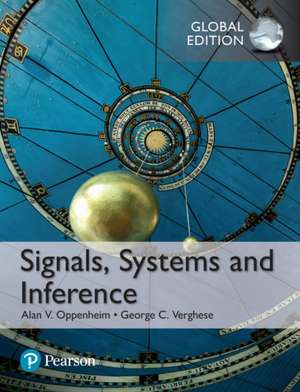Signals, Systems and Inference, Global Edition
Autor Alan Oppenheim, George Vergheseen Limba Engleză Paperback – 18 ian 2017
Preț: 568.09 lei
Preț vechi: 652.98 lei
-13% Nou
Puncte Express: 852
Preț estimativ în valută:
108.71€ • 114.02$ • 90.49£
108.71€ • 114.02$ • 90.49£
Carte indisponibilă temporar
Doresc să fiu notificat când acest titlu va fi disponibil:
Se trimite...
Preluare comenzi: 021 569.72.76
Specificații
ISBN-13: 9781292156200
ISBN-10: 1292156201
Pagini: 608
Dimensiuni: 180 x 231 x 25 mm
Greutate: 0.81 kg
Ediția:Global ed
Editura: Pearson Education
ISBN-10: 1292156201
Pagini: 608
Dimensiuni: 180 x 231 x 25 mm
Greutate: 0.81 kg
Ediția:Global ed
Editura: Pearson Education
Cuprins
Preface
The Cover
Acknowledgments
Prologue
1. Signals and Systems
1.1 Signals, Systems, Models, and Properties
1.1.1 System Properties
1.2 Linear, Time-Invariant Systems
1.2.1 Impulse-Response Representation of LTI Systems
1.2.2 Eigenfunction and Transform Representation of LTI Systems
1.2.3 Fourier Transforms
1.3 Deterministic Signals and Their Fourier Transforms
1.3.1 Signal Classes and Their Fourier Transforms
1.3.2 Parseval's Identity, Energy Spectral Density, and Deterministic Autocorrelation
1.4 Bilateral Laplace and Z-Transforms
1.4.1 The Bilateral z-Transform
1.4.2 The Bilateral Laplace Transform
1.5 Discrete-Time Processing of Continuous-Time Signals
1.5.1 Basic Structure for DT Processing of CT Signals
1.5.2 DT Filtering and Overall CT Response
1.5.3 Nonideal D/C Converters
1.6 Further Reading
Problems
Basic Problems
Advanced Problems
Extension Problems
2. Amplitude, Phase, and Group Delay
2.1 Fourier Transform Magnitude and Phase
2.2 Group Delay and the Effect of Nonlinear Phase
2.2.1 Narrowband Input Signals
2.2.2 Broadband Input Signals
2.3 All-Pass and Minimum-Phase Systems
2.3.1 All-Pass Systems
2.3.2 Minimum-Phase Systems
2.3.3 The Group Delay of Minimum-Phase Systems
2.4 Spectral Factorization
2.5 Further Reading
Problems
Basic Problems
Advanced Problems
Extension Problems
3. Pulse-Amplitude Modulation
3.1 Baseband Pulse-Amplitude Modulation
3.1.1 The Transmitted Signal
3.1.2 The Received Signal
3.1.3 Frequency-Domain Characterizations
3.1.4 Intersymbol Interference at the Receiver
3.2 Nyquist Pulses
3.3 Passband Pulse-Amplitude Modulation
3.3.1 Frequency-Shift Keying (FSK)
3.3.2 Phase-Shift Keying (PSK)
3.3.3 Quadrature-Amplitude Modulation (QAM)
3.4 Further Reading
Problems
Basic Problems
Advanced Problems
Extension Problems
4. State-Space Models
4.1 System Memory
4.2 Illustrative Examples
4.3 State-Space Models
4.3.1 DT State-Space Models
4.3.2 CT State-Space Models
4.3.3 Defining Properties of State-Space Models
4.4 State-Space Models from LTI Input-Output Models
4.5 Equilibria and Linearization of Nonlinear State-Space Models
4.5.1 Equilibrium
4.5.2 Linearization
4.6 Further Reading
Problems
Basic Problems
Advanced Problems
Extension Problems
5. LTI State-Space Models
5.1 Continuous-Time and Discrete-Time LTI Models
5.2 Zero-Input Response and Modal Representation
5.2.1 Undriven CT Systems
5.2.2 Undriven DT Systems
5.2.3 Asymptotic Stability of LTI Systems
5.3 General Response in Modal Coordinates
5.3.1 Driven CT Systems
5.3.2 Driven DT Systems
5.3.3 Similarity Transformations and Diagonalization
5.4 Transfer Functions, Hidden Modes, Reachability, and Observability
5.4.1 Input-State-Output Structure of CT Systems
5.4.2 Input-State-Output Structure of DT Systems
5.5 Further Reading
The Cover
Acknowledgments
Prologue
1. Signals and Systems
1.1 Signals, Systems, Models, and Properties
1.1.1 System Properties
1.2 Linear, Time-Invariant Systems
1.2.1 Impulse-Response Representation of LTI Systems
1.2.2 Eigenfunction and Transform Representation of LTI Systems
1.2.3 Fourier Transforms
1.3 Deterministic Signals and Their Fourier Transforms
1.3.1 Signal Classes and Their Fourier Transforms
1.3.2 Parseval's Identity, Energy Spectral Density, and Deterministic Autocorrelation
1.4 Bilateral Laplace and Z-Transforms
1.4.1 The Bilateral z-Transform
1.4.2 The Bilateral Laplace Transform
1.5 Discrete-Time Processing of Continuous-Time Signals
1.5.1 Basic Structure for DT Processing of CT Signals
1.5.2 DT Filtering and Overall CT Response
1.5.3 Nonideal D/C Converters
1.6 Further Reading
Problems
Basic Problems
Advanced Problems
Extension Problems
2. Amplitude, Phase, and Group Delay
2.1 Fourier Transform Magnitude and Phase
2.2 Group Delay and the Effect of Nonlinear Phase
2.2.1 Narrowband Input Signals
2.2.2 Broadband Input Signals
2.3 All-Pass and Minimum-Phase Systems
2.3.1 All-Pass Systems
2.3.2 Minimum-Phase Systems
2.3.3 The Group Delay of Minimum-Phase Systems
2.4 Spectral Factorization
2.5 Further Reading
Problems
Basic Problems
Advanced Problems
Extension Problems
3. Pulse-Amplitude Modulation
3.1 Baseband Pulse-Amplitude Modulation
3.1.1 The Transmitted Signal
3.1.2 The Received Signal
3.1.3 Frequency-Domain Characterizations
3.1.4 Intersymbol Interference at the Receiver
3.2 Nyquist Pulses
3.3 Passband Pulse-Amplitude Modulation
3.3.1 Frequency-Shift Keying (FSK)
3.3.2 Phase-Shift Keying (PSK)
3.3.3 Quadrature-Amplitude Modulation (QAM)
3.4 Further Reading
Problems
Basic Problems
Advanced Problems
Extension Problems
4. State-Space Models
4.1 System Memory
4.2 Illustrative Examples
4.3 State-Space Models
4.3.1 DT State-Space Models
4.3.2 CT State-Space Models
4.3.3 Defining Properties of State-Space Models
4.4 State-Space Models from LTI Input-Output Models
4.5 Equilibria and Linearization of Nonlinear State-Space Models
4.5.1 Equilibrium
4.5.2 Linearization
4.6 Further Reading
Problems
Basic Problems
Advanced Problems
Extension Problems
5. LTI State-Space Models
5.1 Continuous-Time and Discrete-Time LTI Models
5.2 Zero-Input Response and Modal Representation
5.2.1 Undriven CT Systems
5.2.2 Undriven DT Systems
5.2.3 Asymptotic Stability of LTI Systems
5.3 General Response in Modal Coordinates
5.3.1 Driven CT Systems
5.3.2 Driven DT Systems
5.3.3 Similarity Transformations and Diagonalization
5.4 Transfer Functions, Hidden Modes, Reachability, and Observability
5.4.1 Input-State-Output Structure of CT Systems
5.4.2 Input-State-Output Structure of DT Systems
5.5 Further Reading
